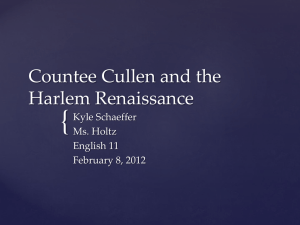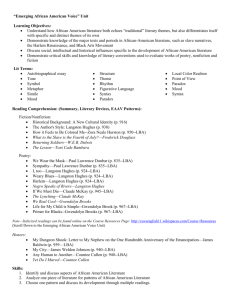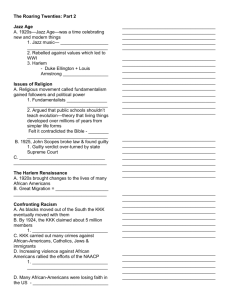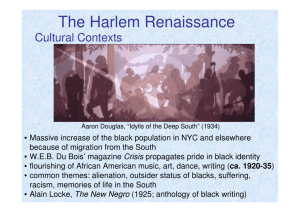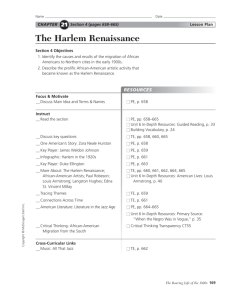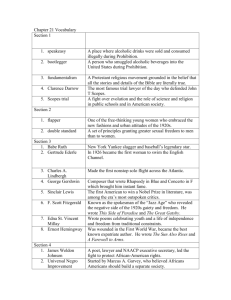Timeline of the Harlem Renaissance
advertisement
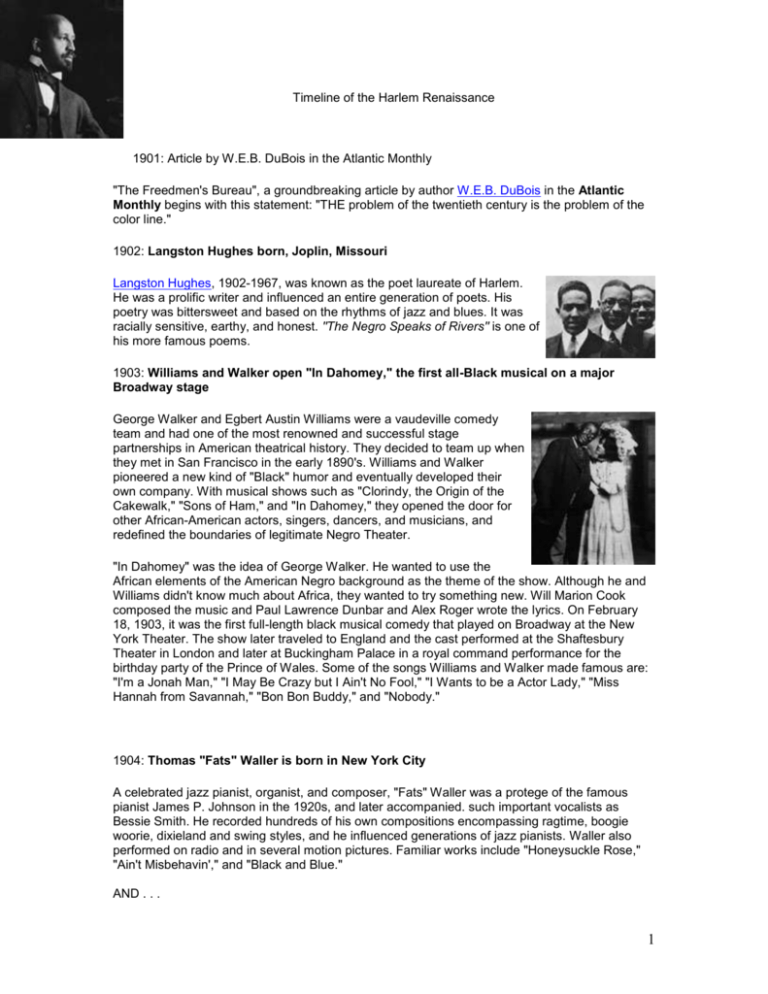
Timeline of the Harlem Renaissance 1901: Article by W.E.B. DuBois in the Atlantic Monthly "The Freedmen's Bureau", a groundbreaking article by author W.E.B. DuBois in the Atlantic Monthly begins with this statement: "THE problem of the twentieth century is the problem of the color line." 1902: Langston Hughes born, Joplin, Missouri Langston Hughes, 1902-1967, was known as the poet laureate of Harlem. He was a prolific writer and influenced an entire generation of poets. His poetry was bittersweet and based on the rhythms of jazz and blues. It was racially sensitive, earthy, and honest. "The Negro Speaks of Rivers" is one of his more famous poems. 1903: Williams and Walker open "In Dahomey," the first all-Black musical on a major Broadway stage George Walker and Egbert Austin Williams were a vaudeville comedy team and had one of the most renowned and successful stage partnerships in American theatrical history. They decided to team up when they met in San Francisco in the early 1890's. Williams and Walker pioneered a new kind of "Black" humor and eventually developed their own company. With musical shows such as "Clorindy, the Origin of the Cakewalk," "Sons of Ham," and "In Dahomey," they opened the door for other African-American actors, singers, dancers, and musicians, and redefined the boundaries of legitimate Negro Theater. "In Dahomey" was the idea of George Walker. He wanted to use the African elements of the American Negro background as the theme of the show. Although he and Williams didn't know much about Africa, they wanted to try something new. Will Marion Cook composed the music and Paul Lawrence Dunbar and Alex Roger wrote the lyrics. On February 18, 1903, it was the first full-length black musical comedy that played on Broadway at the New York Theater. The show later traveled to England and the cast performed at the Shaftesbury Theater in London and later at Buckingham Palace in a royal command performance for the birthday party of the Prince of Wales. Some of the songs Williams and Walker made famous are: "I'm a Jonah Man," "I May Be Crazy but I Ain't No Fool," "I Wants to be a Actor Lady," "Miss Hannah from Savannah," "Bon Bon Buddy," and "Nobody." 1904: Thomas "Fats" Waller is born in New York City A celebrated jazz pianist, organist, and composer, "Fats" Waller was a protege of the famous pianist James P. Johnson in the 1920s, and later accompanied. such important vocalists as Bessie Smith. He recorded hundreds of his own compositions encompassing ragtime, boogie woorie, dixieland and swing styles, and he influenced generations of jazz pianists. Waller also performed on radio and in several motion pictures. Familiar works include "Honeysuckle Rose," "Ain't Misbehavin'," and "Black and Blue." AND . . . 1 Countee Cullen is born in Louisville, Kentucky Born in Kentucky, Countee Cullen was raised New York City by his paternal grandmother. In 1918, he was adopted by the Reverend Frederick Asbury Cullen, minister of Salem M.E. Church, one of the largest congregations in Harlem. This was a turning point in his life; he was introduced to the heart of of Black activism and achievement. Early in his life, Cullen won a citywide poetry contest; his winning verses were widely reprinted. He attended New York University (B.A., 1925), won the Witter Bynner Poetry Prize, and was elected to Phi Beta Kappa. His first collection of poems, "Color" (1925), was be published to critical acclaim before he finished college. Cullen's several volumes of poetry include "Copper Sun" (1927); "The Black Christ" (1929); and "On These I Stand" (published posthumously, 1947) He also wrote a novel dealing with life in Harlem, "One Way to Heaven" (1931), and a children's book, "The Lost Zoo" (1940). 1909: First Meeting of Committee The National Negro Committee (later known as the NAACP) holds its first meeting in New York City. To learn more about the history of the NAACP 1910: First Edition of The Crisis published The Crisis is the official monthly publication of the NAACP. It began in 1910 with William Edward Burghardt DuBois as editor, and became a leading periodical for African Americans. It was known for its radical position against lynching and racial prejudice and reflected the ideology of Dr. DuBois. Until 1919 it sold for 10 cents a copy and boasted a monthly circulation of 80,000 copies. In the 1920s, literary contributions to the magazine increased in keeping with the cultural explosion known as the Harlem Renaissance. The magazine began to sponsor a literary contest and the works of poets Langston Hughes, Countee Cullen and Claude McKay, among others, began to appear. The cover was also illustrated by leading African-American visual artists such as Aaron Douglas, John Henry Adams and Laura Wheeler Waring. The magazine continues to emphasize cultural, social and economic matters. It is still being published monthly by the NAACP. 1911: The National Urban League Is Launched In October 1911, three organizations, The Committee for Improving the Industrial Conditions of Negroes in New York, The Committee on Urban Conditions and The National League for the Protection of Colored Women merge, under the leadership of Dr. George E. Hayne and Eugene Kinckle Jones, to form the National Urban League. Eugene Kinckle Jones is named executive secretary. 1916: Madame C.J. Walker moves to New York City Madame C.J. Walker was born in 1867 to Owen and Minerva Breedlove, former slaves. She married C.J. Walker at fourteen and had a daughter, L'Aliea. While working as a laundress Walker nurtured her dream of making a preparation that would "improve" the texture of African women's hair. She set out with $1.25 and plenty of determination to become America's first self-made woman millionaire. She developed a line of cosmetics and hair care products especially for African-American women. She sold her wares door to 2 door at first, then established a company based in Indianapolis, Indiana. In Indianapolis she employed thousands of people to manufacture and sell her products all over the United States, Central America, and the Caribbean. Madame Walker moved to Harlem in 1916 and opened an elegant and fully equipped beauty salon. In 1917 she bought another property and built a mansion, where she entertained the rich and famous. Madame Walker was also a human rights activist, and visited the White House as part of a delegation that was petitioning President Woodrow Wilson to make lynching a federal crime. She also travelled around the country promoting her products and speaking out on women's and African-American rights. C.J. Walker died in 1919, leaving her business and her legacy to her daughter, L'Aliea, who continued her work. 1917: Silent Protest Parade in New York, July 27th On July 28, 1917 in New York City, a Silent parade was staged in protest of the East St. Louis, Illinois Massacre of July 2, 1917, as well as the recent lynchings in Waco, Texas and Memphis, Tennesee. The march was organized by the NAACP, churchmen and other civil leaders to protest the violent events against African Americans around the country. The United States had just entered World War I and many were questioning the use of African-American soldiers to fight in a war that President Woodrow Wilson had described as necessary to the survival of democracy abroad, especially at a time when these same men and their families were denied their basic rights here in the U.S. The riots in East St. Louis began when whites, angry because African Americans were employed by a factory holding government contracts, went on a rampage. Over $400,000 worth of property was destroyed. At least 40 African Americans were killed. Men, women and children were beaten, stabbed, hanged and burned. Nearly 6,000 African Americans were driven from their homes. On July 28, 8,000 African Americans, primarily from Harlem, marched silently down Fifth Avenue. They were dressed in their finest clothes and marched to the sound of muffled drums. They carried picket signs while thousands of New Yorkers watched from the sidewalks. The children marched as well as the adults. Some of the banners read: "Mother, do lynchers go to heaven?" , "Mr President, why not make America safe for democracy?", "Pray for the Lady Macbeths of East St. Louis", and "Give us a Chance to Live". 369th Black Regiment embarks for France, November When World War I started in 1914, President Woodrow Wilson proclaimed the United States neutral. However, in 1917, the U.S. formally declared war. At the start of the war, African Americans volunteered for the Armed Services and were rejected. But on May 18, 1917, the Selective Service Act was passed, providing for the enlistment of all able-bodied American men between the ages of 21 and 31. Before the end of these enlistments, over 2 million black men had registered. James Europe, who had been touring with the dancers Vernon and Irene Castle, was asked by Colonel William Haywood to organize a band for the U.S. 15th Infantry. Europe brought men from all over the U.S. and from Puerto Rico to form one of the most popular overseas bands during the war. The 15th New York Infantry was training in Spartansburg, South Carolina when a racial incident occurred involving Noble Sissle, the drum major. When the other militiamen heard about the incident, they wanted to retaliate. But Lt. James R. Europe, the bandmaster, ordered the men to disperse. The War Department decided to send the 15th N.Y. Infantry, now the 369th Regiment of the U.S. Army to 3 France. They became the first contingent of African-American combat troops to go to war. They were nicknamed the "Harlem Hellfighters" and performed for the troops and the French people and government officials during the war, bringing jazz to France. 1920: Springarn Medal Awarded The Springarn Medal is awarded by the NAACP to author, historian and educator W.E.B. Du Bois for "the founding and the calling of the Pan African Congress”. Review of "The Emperor Jones" In November 1920, the New York Times and Tribune described actor Charles Gilpin's portrayal of Brutus Jones in Eugene O'Neill's play 'The Emperor Jones' as "a performance of heroic stature." This was the first dramatic production in an all-white theater to star an African-American actor. Gilpin had premiered in the play earlier that month with the Provincetown Players in Greenwich Village. Gilpin was named one of the ten most important contributors to the American theater of 1920 and in 1921 received the NAACP's Springarn medal for his work. Author James Weldon Johnson becomes the first African-American executive secretary of the NAACP in November, 1920. 1922: Duke Ellington Moves to New York City After founding his first band in 1919, Edward Kennedy "Duke" Ellington moves to New York City in 1922. His five-year tenure at the famed Cotton Club will garner him widespread acclaim. In 1924, he composes his first musical and releases his recording debut. Known as a jazz composer, Ellington will also become renowned for his Sacred Concerts in the mid1960's. Among his most notable works are "Take the A Train," "Mood Indigo," "Sophisticated Ladies," and "I Got It Bad and That Ain't Good." 1923: The first issue of Opportunity published Opportunity was the literary organ of the National Urban League. Countee Cullen won second prize in the Opportunity literary contest in 1925, and became the assistant editor for the magazine in 1926, under Charles S. Johnson. Other Opportunity prize winners included Zora Neale Hurston, who also won second place awards in 1925 for her story "Spunk" and a play, "Color Struck." 1924: Dixie to Broadway Revue Opens! Starring Florence Mills, "Dixie to Broadway", a musical revue featuring an African-American cast, premieres at the Broadhurst Theater in New York City. The music is written by Will Vodery, an African-American, who arranged music for the Ziegfeld Follies for 23 years. 1926: Crisis Magazine . The Crisis magazine led by editor W.E.B. DuBois, awards its first prizes in literature and art. Among the winners are be Arna Bontemps' poem "Nocturne at Bethesda," Countee Cullen's poem "Thoughts in a Zoo," Aaron Douglas' painting "African Chief" and a portrait by Hale Woodruff. 4 1930: The Northeasterners Founded . The Northeasterners Inc., started as a social club in 1930. It was founded by Agatha Scott, wife of Brigadier General Benjamin O. Davis, Jr., in New York. The idea came to Mrs. Davis, who was impressed with the young AfricanAmerican debutantes she met while visiting several cities. The idea caught on and several young women representing various states in the Northeast came together with the aim of keeping in touch with each other socially, keeping abreast of cultural trends and rendering service to the community. Club records show various projects were organized to aid community and educational causes. Some of these include an annual scholarship to Howard University, contributions to the Infantile Paralysis Library Project at Tuskegee Institute, contributions to the NAACP, the Urban League, the United Negro College Fund and the American Cancer Society, among others. The present organization is national in scope with a national constitution. The various chapters meet at an annual National Conclave held in different locations each year. The organization encourages young women to join and strive towards a standard of excellence and a commitment to community services. The organization voted to change its name in 1979 to The Northeasterners. 1934: Campaign Against Segregation At a conference in October, 1934 in New York City, representatives of the NAACP and the American Fund for Public Service plan a coordinated legal campaign against segregation and discrimination. Charles H. Houston, Vice-Dean of the Howard University Law School, is named director of the NAACP legal campaign. 1935: Hughes' Play Opens in New York In October 1935, poet and novelist Langston Hughes's play "Mulatto" opens on Broadway. It will have the longest run of any play on by an African American until Lorraine Hansberry's "A Raisin in the Sun." 1936: Academy Award Winning Actor Born in Brooklyn, New York Louis Gossett, Jr. is born in Brooklyn, New York. He debuted at 17 in "Take a Giant Step" and performed in many stage, film and television roles, including "Roots," for which he received an Emmy Award. His portrayal of a tough drill instructor in the 1982 film"An Officer and a Gentleman" brought him an Academy Award as best supporting actor. He is the third AfricanAmerican to win an Academy Award for acting. 1937: Their Eyes Were Watching God, by Zora Neale Hurston, published Zora Neale Hurston was born on January 7th, 1891 in Eatonville, Florida. Her hometown and her experiences there provided inspiration for several of her novels, including the autobiographical Dust Tracks on the Road. Hurston attended Morgan Academy in Baltimore for high school, and studied afterward at Howard University in Washington, D.C.. From 1925 to 1927 Hurston attended Barnard College, studying anthropology with Dr. Frank Boaz. She subsequently did field research recording the folklore and ways of African Americans, first in Harlem and then throughout the rural South. Her work played a large role in preserving the folk traditions and cultural heritage of African Americans. 5 Hurston was ahead of her time. Her literary activities were influential in bridging the gap between what came to be known as the first and second phases of the Harlem Renaissance. She began writing short stories in the 1920's, but her major acheivements were generally between 1931 and 1943, when she wrote scholarly works on folklore and published six major novels. She was on the vanguard of the modern literary movement. Several of her books won recognition and her stories were published in the leading literary magazines of the times. Her most notable novel was Their Eyes Were Watching God, a classic in American literature. 1938: Harlem Suitcase Theatre features Hughes' Play In New York city, the Harlem Suitcase Theatre opens with Langston Hughes' play "Don't You Want to be Free?" The play's star is a young Robert Earl Jones, father of acclaimed actor James Earl Jones. 1939: New publication by McKay Jamaican-born author Claude McKay published Harlem: Negro Metropolis (E.P. Dutton and Co), documenting the creative artists, authors and revolutionary thinkers in Harlem prior to WWII. An illustration from this book is included below, entitled "Women of Harlem". 6
